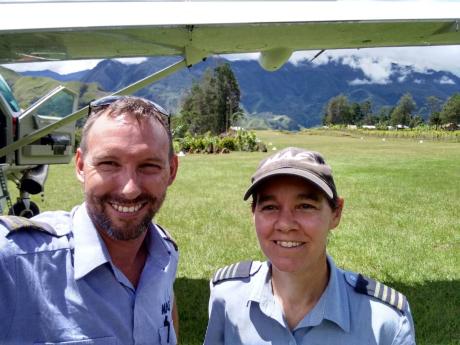MAF pilot Bridget Ingham shares about her recently completed Advanced Airstrip Training, landing at some of the most challenging bush airstrips in the highlands.
Dramatic music plays as the camera follows a small plane weaving in and out of clouds, flying between steep forested hills. A few seconds later, a clearing appears, except it’s not a clearing - it’s an airstrip, perched on the side of a mountain and only slightly longer than it is wide. The plane somehow lands on the postage stamp of grass, the picture fades to black, and the MAF logo appears...
Most of us have seen the promotional videos - now it was my turn to learn how to land on the kinds of airstrips that feature in them!
In PNG, the airstrips are graded from A to D in difficulty. Up until now I have only been able to be trained at A, B and C strips. If an airstrip is less than 500m long, and/or more than 10% slope, it is automatically classified as a D. The flight operations manager can also designate any airstrip as a D if the circuit, prevailing wind, or surface makes it tricky.
The Goroka base services a number of such airstrips. So it was arranged for me to go to Goroka for advanced airstrip training. The goal of the course was to develop the skills, confidence and precision to be able to land on short airstrips (precision), steep airstrips (technique) and others with challenging circuits or surface conditions (e.g. slippery).
There comes a point where you will be unable to outclimb the terrain or turn around, so you are committed to land while still in the air.
Over the course of four days, we went to 14 different airstrips, each one presenting different challenges - unusual circuits (some of which I was given the challenge of figuring out myself without looking at the airstrip diagram), steep slopes, rough and/or slippery surfaces (which makes taxiing just as much of a challenge as landing and taking off). The shortest airstrip we went to was Owena, which is only 380m long (with 12.5% slope), and the steepest had a section of 16% slope (see main image).
Steep airstrips can be quite intimidating. When landing, they are prone to giving you visual illusions, especially as you get closer to the touchdown point. There comes a point where you will be unable to outclimb the terrain or turn around, so you are committed to land while still in the air. When it comes to landing, the key is ‘energy management’, both in the flare and after touching down - you can’t afford to stop moving, or else the plane could tip backwards onto its tail (or even start sliding backwards down the hill). Add in a rough or slippery surface to the mix and you’ve got quite the challenge. When taking off, ‘brakes release’ is often the point at which you are committed to the take-off, and everything happens much faster in terms of acceleration and the associated sideways yaw of the aircraft.
Having completed my advanced airstrip training, I'm glad it wasn't scheduled any earlier - it was quite intense, but I noticed big improvements.
The following week I had a few days in the Western Province and was pleased with how much more accurate my landings were at the airstrips that I normally fly to!
Following the initial training, I got checked into more D strips around Mt Hagen. One day, I was scheduled to fly with another instructor to four such strips. At the third airstrip, for which we were delivering some cargo, we were informed by the agent that a family had arrived from another village the night before with a child who had meningitis. He asked if we could medevac them to Kompiam. Knowing how quickly the child’s health could deteriorate, it was a no-brainer to cut the training short and do the medevac flight instead. In the midst of a day where, admittedly, I was focusing on myself, it was good to be reminded once again of why we are here.
